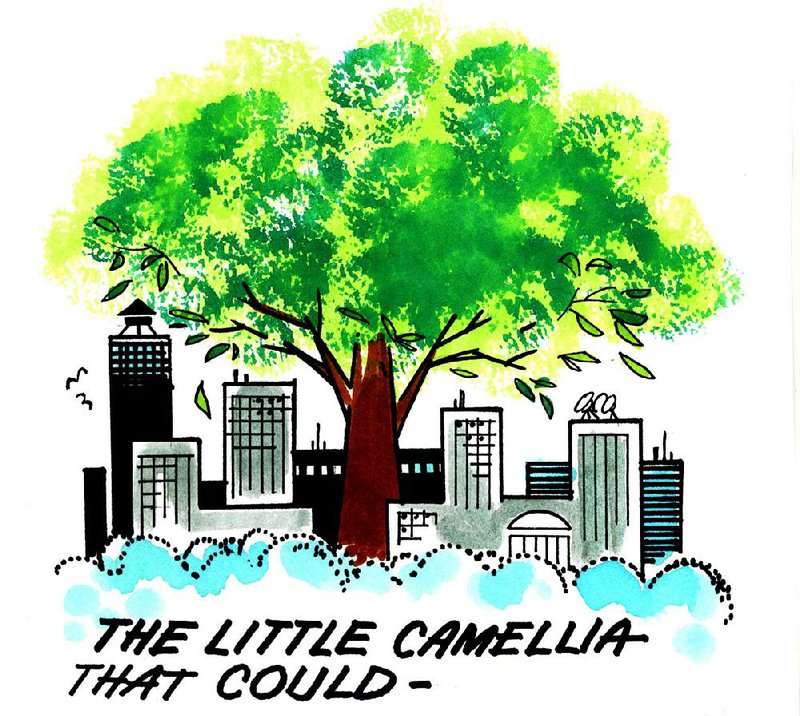Q I have a camellia that was a bush in 1972 when we moved here. Through neglect, it became a mighty tall tree. Should I prune it or just leave it alone? It is absolutely beautiful now.
A I often am asked about pruning large blooming plants. The assumption is that they need to be tamed or kept into a specific framework. If the plants are impeding movement on a sidewalk or driveway, or covering up a window or door, then pruning is in order. If they are growing in an area that has plenty of room, then let them grow and enjoy them.
I agree your plant is stunning. Tree-forming an overgrown specimen -- which is what has happened with your camellia -- by removing the lower branches and exposing the main trunk helps your plant make a statement in the garden. So, enjoy. If you have camellias that are blocking something, wait until winter is fully over before doing any pruning.
Q I recently moved into a new house in Little Rock, and the lawn is not what I would like to see. I have full sun in the front and a lot of shade in the back. I am considering seeding Bermuda in the front and centipede in the back. How soon can I throw seed out, and any tips on getting it established quickly?
A The fastest way to get a lawn established is by sodding. If you want to seed, pay attention to the weather forecast in the spring. You want some soil warmth, but also you also want to take advantage of spring rains. May is when we usually have warm enough soil for good germination. Bermuda will establish much more quickly than centipede will. Centipede is slow-growing in sunny conditions but will be even slower in the shade.
If the shade is dense, you could consider a groundcover or mulch instead, since grass does not easily grow in the shade. Centipede and St. Augustine are the best choices for shade, but St. Augustine needs to be sodded. The University of Arkansas Division of Agriculture's Cooperative Extension Service has a free fact sheet on establishing lawns here. To find it, visit uaex.edu and search for FSA-2113.
Q Could you please give me some information about a shrub called Carolina Midnight loropetalum? I saw it recently in a magazine, and I think it might be good for my garden. Will it grow in Cabot?
A Loropetalums have become a favorite garden plant in Arkansas. The evergreen, dark purple foliage coupled with hot pink fringe flowers in the spring make it a popular choice; and it reblooms sporadically throughout the growing season. It also grows in full sun to partial shade and is quite drought-tolerant once established. There are many varieties of loropetalum, and their mature size varies drastically. The smallest one is "Purple Pixie," growing no more than 8 inches to 18 inches in height but spreading. It is slow growing. Carolina Midnight is a taller introduction, growing 10 to 15 feet tall at maturity.
Choose a variety that will grow only as tall as you need so you are not required to prune annually. The one that interests you is probably a bit tall for a foundation planting but would make a good screen or hedge. A more moderately sized plant would be Plum Delight at 6 to 8 feet tall or the even shorter Ruby at 3 to 5 feet tall.
Q I have a hedge of winter honeysuckle that I love. It has such fragrant blooms and needs no care. I need help to know when to prune it. I would like a little more of a formal look rather than the natural look it has now. I don't know why more people don't plant this. It grows with almost no care and is so fragrant in the late winter.
A OK, I am probably going to make some readers upset, because I agree. I like this plant. It has made its way onto some invasive plant lists, and there are a few spots in Little Rock where the plant has escaped and reseeded. It is not one of the two invasive species in Northwest Arkansas, which are Tatarian honeysuckle (Lonicera tatarica) and Amur honeysuckle (Lonicera maackii). Tatarian has pink flowers, and Amur has white to yellow blooms. Both bloom profusely after the plants have leafed out in the spring and smell great in bloom -- but they set an abundance of seeds, which the birds eat and drop, and thus they spread.
I would not encourage planting either one of these honeysuckles. Winter honeysuckle (Lonicera fragrantissima) is usually better-behaved, with small white blooms before the foliage comes on. There is some seed set, which can lead to problems. To prevent berry spread, prune your winter honeysuckle in the spring after it flowers. This will give you the shape you want and prevent the seeds from maturing. In most gardens, this has not been a problem, but we do need to use caution. If your plant begins to get too woody, thin out some of the older, woodier canes when you prune.
Janet B. Carson is a horticulture specialist for the University of Arkansas Cooperative Extension Service. Write to her at 2301 S. University Ave., Little Rock, Ark. 72204 or email her at
jcarson@arkansasonline.com
HomeStyle on 12/12/2015
